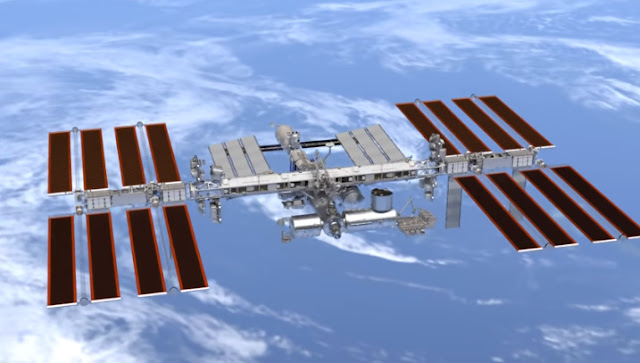So funny story, I often leave youtube on in the background while I build lego (I like the background noise). I was building the lego ideas version and the shuffle of one of my playlists took me to this video. And I was like "well that's nice". on the plus side I was able to identify the different parts of the station while I built it.

I want to give you a detailed look at the station. We’re gonna look at each module in the order that they were assembled. The International Space Station, or ISS, took many years to become a reality. It was never actually built in it original form. There were lots of redesigns, and its funding was almost completely cut by US Congress.
Its located just outside the Earth’s atmosphere. This is called Low Earth Orbit. It’s not very high up, considering that some satellites orbit way out here. The ISS only takes about 92 minutes to orbit the earth. That’s about 28,000 kilometers per hour.
To prevent this, the station must be periodically rebooted to stay in space. The main countries now participating are United States, Canada, Russia, Japan and many countries from the European Space Agency.
Let’s get to know the main parts of the station. The Integrated Truss Structure is kind of like the backbone of the station. This part down here contains the pressurized modules, which means the astronauts can live and work in here without a space suit. The other side is called the United States Orbital Segment. It’s made up of modules from the United States, Europe, Japan and Canada.
Each module was then launched into space by one of these three rockets, the American Space Shuttle, the Russian Proton Rocket and the Russian Soyuz Rocket. Once in space, it’s time to put it all together. Let’s go ahead and start at the very beginning. The first piece of the station is a Russian module called Zarya. It provides power from the solar arrays and also propulsion when there’s a need to move the station.
These will be used to connect to the next pieces of the station. This is called a Pressurized Mating Adapter, or PMA for short. Unity was launched with PMA-1 and PMA-2. This is the Zvezda service module. It also has three docking ports in front and one in back. Next is the Z1 Truss. This holds equipment for the station. It’s not part of the main truss, but it provided a temporary mounting place, as well see here in a moment. PMA-3 was then added to the bottom side of Unity. It’s always good to have an extra one of these around.

It’s usually controlled by an astronaut Either end of the arm can be attached to one of these grapple fixtures that you’ll find on various modules. The Quest airlock allows the astronauts to safely step outside for a few hours to perform an EVA, also known as a spacewalk. This is a Russian module called Pirs. It can be used as an airlock for spacewalks or as a docking port to allow visiting spacecraft to attach to the station.
If you remember from earlier, this is kind of like the backbone of the station. Our first piece is the S0 Truss, and it gets attached to the top of the Destiny module. The Mobile remote servicer Base System, or MBS, was added next. This platform can move along the truss. It’s especially useful when the Canadarm2 is attached. Then the S1 Truss was added followed by the P1 Truss. The S stands for starboard and the P stands for port.
This way, you know on which side of the station it’s on. Each side has room for three more radiator panels. ESP-2 was added to the station right next to the Quest airlock. The tiny P5 Truss goes at the end here. The following year, the other sides of the truss were added as well. ESP-3 goes down here. Now we get some more robotics also built by Canada. This is a space robot called Dextre. In fact, Dextre is most useful when its attached to the end of the Canadarm2. The largest module is the Japanese Experiment Module, also known as Kibo.
It even has its own robotic arm. Now were starting to look a little more like the space station. This helps the arrays generate more power for the station. It’s called the Japanese Exposed Facility. This allows research to be conducted in the vacuum of space.
The Russian module Poisk is very similar to Pirs. It was another place for Russian spacecraft to dock. This is the first ExPRESS Logistic Carrier, or ELC-1. The trash will build up here until it can be removed from the station. Here’s ELC-3 and -4. This is a science experiment called the Alpha Magnetic Spectrometer.
It’s used to study rare particles such as antimatter. A more recent addition to the station is called the Bigelow Expandable Activity Module, or BEAM for short. It takes up a small amount of space during launch and then inflated once attached to the station. BEAM is an experiment to see if this kind of technology can work. The ISS only has funding through 2025. But hopefully, that will be extended. After that, we may see pieces of the station repurposed for other projects in space.

Comments
Post a Comment